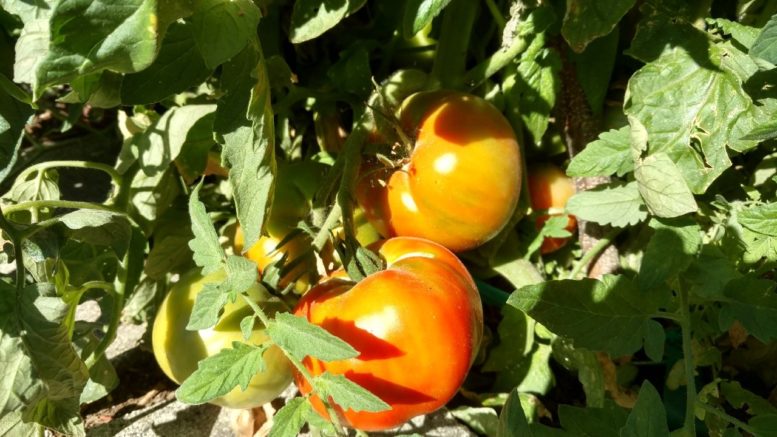Sacramento has the sun and heat tomato plants crave. But how much is too much?
Sacramento loves tomatoes. The feeling is mutual.
Any Sacramentan with a few square feet of outdoor space grows tomatoes (or wants to) with dreams of hefty slicers by the Fourth of July. There’s a reason our tomato mania is so strong: Tomatoes thrive here.
Our area has plenty of what tomato plants crave: Sun and heat. But how much is too much?
Prolonged triple-digit heat waves can toast tomatoes. Last week’s 104-degree spike was a taste of the challenges to come.
When temperatures stay above 90 degrees for several days, tomato flowers may drop off or refuse to set fruit. Leaves can fry and turn crispy. Ripening tomatoes may split or develop calluses.
So give your vines a hand—along with enough water and shade—to cope with extreme heat. This advice comes from UC Cooperative Extension master gardeners as well as longtime local tomato growers.
Water early and deep. Each tomato plant needs at least five gallons a week. Irrigate your tomatoes in the morning, making sure water reaches down at least 6 inches into the soil. How do you know? Test the soil with a probe or long screwdriver; it should easily plunge into the soil. Or use a trowel, dig down (away from the roots) and look.
During hot weather, water tomatoes two to three times a week. Tomatoes normally wilt during a hot afternoon; that’s OK. But if they’re wilted in the morning, water immediately. Some tomato varieties will wilt every day during summer heat regardless of how much water they receive. This tends to happen with Russian heirlooms such as Black Krim.
Tomatoes planted in containers may need extra water every day during hot weather. Their potting soil tends to dry out faster. Plants in black containers are particularly susceptible to heat-related problems.
Keep watering consistent and don’t let soil dry out completely. That can lead to blossom end rot—the hard brown callus on the flower end of a tomato. Inconsistent watering also can cause fruit to split.
Mulch is your tomato plant’s friend. Make sure your vines have at least 2 to 4 inches around them to help keep roots cool and soil evenly moist. Straw, leaves or shredded bark make the best tomato mulch. Many gardeners prefer straw (not hay) because its light color reflects intense sun rays instead of absorbing heat. Hay also contains seeds that can sprout and suck nutrients out of soil.
Don’t fertilize during a heat wave. It just puts more stress on the plant. When you do feed them, stay away from high-nitrogen fertilizers; they’ll produce luxurious vines but no tomatoes.
Tomatoes love sun, but they can get sunburned. If leaves or developing fruit look bleached out, give your vine some afternoon shade by draping burlap or shade cloth over the tomato cage or trellis. This also helps prevent fruit from cracking.
If foliage turns brown, leave the dead leaves in place. They help protect the fruit from sunburn. After the heat has subsided, prune off the completely dead leaves so new foliage can grow.
With these tips, your tomatoes can flourish all summer long. They’ll be happier plants, and you’ll be a happier gardener, too.






Be the first to comment on "Hot tomato"